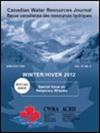天气预报前置时间对集合水温预报演变的量化研究——以Nechako河流域为例
IF 1.7
4区 环境科学与生态学
Q3 WATER RESOURCES
引用次数: 1
摘要
通过概率方法计算不确定性的同时,生成和改进水文和水动力预测在水温预测等各种应用中都很有用。为了生成这样的集合,可以将概率气象预报输入到不同交货期的水文和水温模型中。本研究旨在评估气象预报质量对基于HEC-RAS过程的热液模式生成的水温预报集合的准确性和可靠性的影响。加拿大不列颠哥伦比亚省的管理河流系统Nechako河被用于本案例研究。生成并评估了2017年至2020年的热预报。经检验的假设是,气象预报的改进将会减少不确定性,并提高水温预报系统在不同前置时间的准确性。研究结果表明,热预报的清晰度和单项精度确实有所提高,但对整体精度没有明显影响。结果表明,在Nechako河上,水温预报集合最初分散不足,当HEC-RAS模式与质量较好的集合天气预报相结合时,这一问题加剧。分析了沿江湖泊的存在和气象预报的可靠性是造成这一问题的原因。综上所述,减少气象输入的不确定性并没有改善该系统水温预报的不确定性表征。本文章由计算机程序翻译,如有差异,请以英文原文为准。
Quantifying the evolution of ensemble water temperature forecasts as a function of weather forecast lead-time: case study on the Nechako River watershed
Abstract Producing and improving hydrological and hydrodynamic forecasts while accounting for uncertainty through a probabilistic approach is useful in various applications, such as for water temperature forecasting. To produce such ensembles, probabilistic meteorological forecasts can be fed into hydrological and water temperature models for different lead-times. This study aims to gauge the impact of the meteorological forecast quality on the accuracy and reliability of water temperature forecast ensembles generated through the HEC-RAS process-based hydrothermal model. The Nechako River, a managed river system in British Columbia, Canada, is used in this case study. The thermal forecasts were generated and evaluated from 2017 to 2020. The tested hypothesis is that improvements in the meteorological forecasts would result in reducing the uncertainty and improving the accuracy of the water temperature forecast ensembles at various lead-times. The results of this study show that the thermal forecasts were indeed improved in terms of their sharpness and their individual accuracy, but no significant impacts were noted over the accuracy of the ensembles. Reliability was also investigated, and it was revealed that water temperature forecast ensembles were initially under-dispersed over the Nechako River, and that this issue was exacerbated when the HEC-RAS model was forced with better quality ensemble weather forecasts. The presence of lakes along the river and the meteorological forecast’s reliability are considered and discussed as causes for this issue. Overall, it was concluded that a reduction of the meteorological inputs’ uncertainty did not improve the uncertainty representation of water temperature forecasts for this system.
求助全文
通过发布文献求助,成功后即可免费获取论文全文。
去求助
来源期刊

Canadian Water Resources Journal
WATER RESOURCES-
CiteScore
2.90
自引率
5.90%
发文量
17
审稿时长
>12 weeks
期刊介绍:
The Canadian Water Resources Journal accepts manuscripts in English or French and publishes abstracts in both official languages. Preference is given to manuscripts focusing on science and policy aspects of Canadian water management. Specifically, manuscripts should stimulate public awareness and understanding of Canada''s water resources, encourage recognition of the high priority of water as a resource, and provide new or increased knowledge on some aspect of Canada''s water.
The Canadian Water Resources Journal was first published in the fall of 1976 and it has grown in stature to be recognized as a quality and important publication in the water resources field.
 求助内容:
求助内容: 应助结果提醒方式:
应助结果提醒方式:


